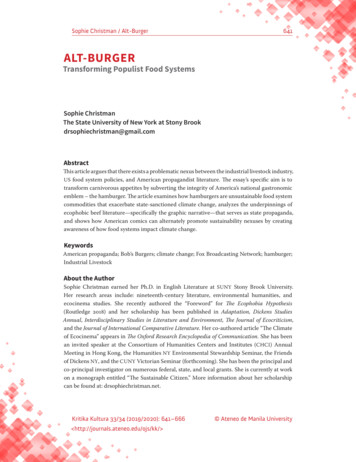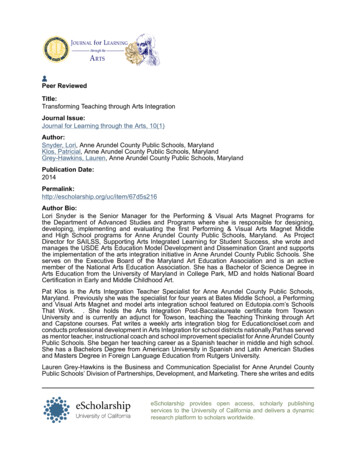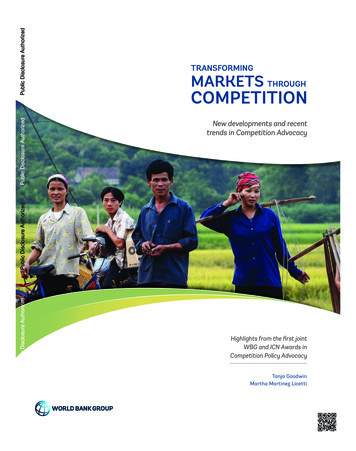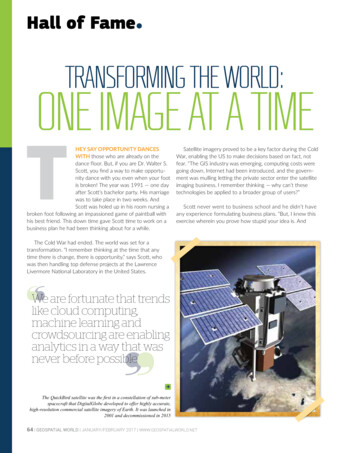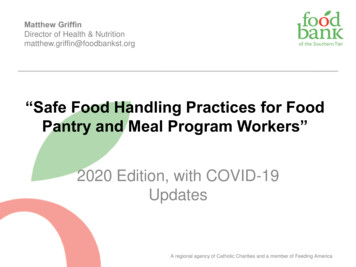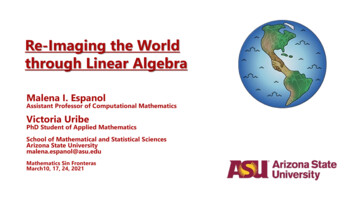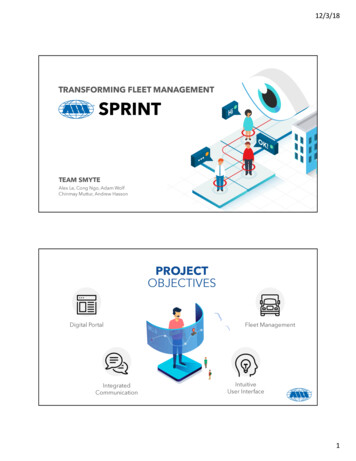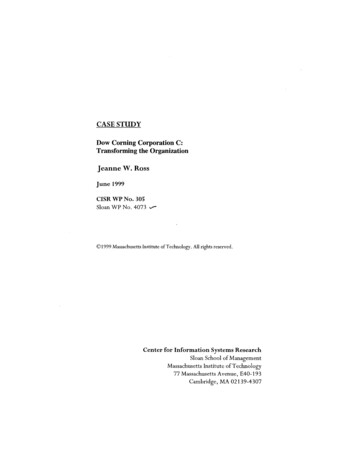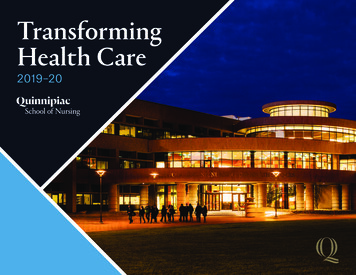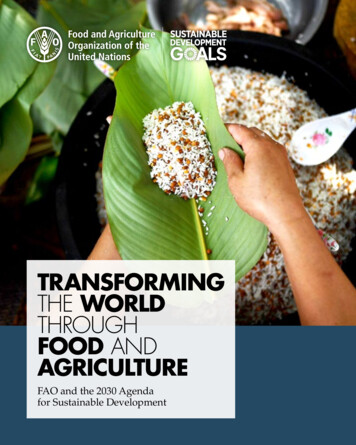
Transcription
TRANSFORMINGTHE WORLDTHROUGHFOOD ANDAGRICULTUREFAO and the 2030 Agendafor Sustainable Development
TRANSFORMING THE WORLD THROUGH FOOD AND AGRICULTURECONTENTSPAGE 4INTRODUCTIONPAGE 5FOOD AND AGRICULTURE IN THE 2030 AGENDAPAGE 6KEY MESSAGESPAGE 7ZERO IN ON ZERO HUNGERPAGES 8–9‘ARE WE THERE YET?’PAGES 10–13LEAVING NO ONE BEHINDPAGES 14–15HEALTHY PEOPLE, HEALTHY PLANETPAGES 16–17THE CLIMATE IS CHANGING. AGRICULTURE MUST TOOPAGES 18–19POWERING THROUGH: THE CHALLENGE OF RESILIENCEPAGES 20–21FOOD AND AGRICULTURE MATTERPAGES 22–23TEAMING UP FOR THE SDGSPAGES 24–25POLICY SUPPORTPAGES 26–31JOINING FORCES AT COUNTRY LEVELPAGE 32TRACKING PROGRESSPAGE 33FAO CUSTODIANSHIP INDICATORS TABLEREFERENCESCover photo: LAO PEOPLE'S DEMOCRATIC REPUBLIC.Local village women prepare meal at the Ban Bor Primary School. FAO/M. Vatsyayana2 FAO/M.ValenciaPAGES 34–35
3
TRANSFORMING THE WORLD THROUGH FOOD AND AGRICULTUREINTRODUCTIONA world facing escalating threats demandsthat we act without delay to safeguardlivelihoods, future-proof our planet and lockin sustainable outcomes. The 2030 Agenda isthere to guide us. But the historic consensussurrounding its adoption must be matched bypolitical determination to deliver it.Seventeen sustainabledevelopment goals (SDGs).One-hundred-and-sixty-nine targets.Two-hundred-and-thirty-twoindicators. In September 2015, UNMember States unanimously signedup to a new vision for humanity.By tying broad principles to detailedbenchmarks, the 2030 Agenda chartsa bold path. It squarely commits theinternational community to endingpoverty, hunger and malnutrition.Its vision is one in which a healthy,prosperous and dignified life, rootedin thriving ecosystems, is a realityfor all; a vision in which no one isleft behind.Explicit in Goal 2 – Zero Hunger– but implicit throughout, theconcept of food security andnutrition underpins the 2030Agenda. It is inseparable fromthe urgency to eradicate extremedeprivation; overhaul foodsystems in the broadest sense;tackle climate challenges; buildcommunity resilience; andresponsibly manage naturalresources and rich biodiversity.Yet on many counts, progressis faltering.This should not be so. In theirambition and reach, the SDGshave been described as the tidethat lifts all boats. They applyto all countries, developed anddeveloping. Priorities vary; needsand capacities too. Strategies andimplementation plans will benationally designed and nationallyowned. But action must be takentogether. With barely a decade todeadline, partnerships are vitaland leadership essential.In this global endeavour, the worldwins or fails as one.4HIGH-LEVELPOLITICALFORUMIn what could indicate freshpolitical momentum, some50 countries have submittedvoluntary reviews to the 2019UN High-Level Political Forum.Now in its fourth year, theinter-governmental meetingidentifies progress andobstacles, offers guidance andrecommendations, and providesinstitutional impetus towardsachieving the 2030 Agenda.
FOOD ANDAGRICULTURE INTHE 2030 AGENDAAround the world, over820 million – one in nine of theworld’s population – are stillchronically undernourished.Among children, more thanone in five is stunted.But malnutrition is not abouthunger alone: poor or unhealthydiets are causing micronutrientdeficiencies. Individual andpublic health is reeling from anunfolding obesity epidemic andassociated non-communicablediseases. In nation after nation,the repercussions of climatechange are compromisingdevelopment gains, furtherfuelling tensions in conflictzones. Unstructured urbanizationdegrades ecosystems whilefailing to fulfil the promise ofprosperity for all. And as resourcedepletion threatens our planet’scontinued viability, humanityseems willing to further mortgageits future through irreversiblebiodiversity loss.From this alarming perspective,the rural poor – four-fifths of allof those living in poverty – mayappear as another dispiritingdataset. It takes vision andcourage to see them as anuntapped resource. Socially leftbehind and afflicted by some ofFocusing on food and agriculture, investingin family farmers and transforming the ruralsector can spur progress towards SDG targets.the worst nutritional indicators,they nonetheless supply 80percent of the world’s food.In many countries, agricultureremains the largest employer andmain economic sector – a majorproblem and major opportunityrolled into one.To achieve the SDGs, we mustimperatively make it less of theformer and more of the latter.The 2030 Agenda recognizes thefundamental connection betweenpeople and planet, agricultureand sustainability. This awarenessmust urgently be translated intoinvestment in rural people, familyfarmers, fishing communities,foresters and pastoralists; in foodsystems that are better balanced,more equitable and less wasteful;in agricultural innovation; and inan approach to natural resourcesthat allies environmental concernsto the pursuit of food security anddecent livelihoods for all.5THE SDGs:A VIRTUOUSCIRCLEActions to achieve SDG2(End hunger, achieve foodsecurity and improved nutrition,and promote sustainableagriculture) will accelerateprogress across most othergoals and targets, includingpoverty (SDG1), health (SDG3),education (SDG4), genderequality (SDG5), water (SDG6),economic growth (SDG8),industry, innovation andinfrastructure (SDG9), inequality(SDG10), sustainable productionand consumption (SDG12),climate change (SDG13),oceans and seas (SDG14),ecosystems, biodiversity andforests (SDG15) and peacefulsocieties (SDG16).
TRANSFORMING THE WORLD THROUGH FOOD AND AGRICULTUREKEYMESSAGESWE MUST GETHUNGER BACKON A STEEPDOWNWARDTREND IF WE ARETO ACHIEVE THESDGs BY 2030.The recent rise in world hungerhas slowed. But more than 820million people still do not haveenough to eat. The stubbornly highhunger levels seen in recent yearsthreaten to derail the 2030 Agenda.For the world to change course, thepolitical gears must shift decisively.The international communitymust work to end conflicts;mitigate climate variability; reduceinequality; and invest in creatingmore equal and inclusive societies.Social protection programmesmust be established – and scaledup dramatically where theyalready exist.WE MUST TRANSFORMFOOD AND AGRICULTURESYSTEMS TO NOURISHPEOPLE, NURTURE THEPLANET AND BUILDRESILIENT LIVELIHOODSALL AT ONCE.To feed a projected 10 billionpeople in 2050, we must pivottowards nutrition-conscious,sustainable agricultural andconsumption practices; designand enact pro-poor growthpolicies; and support thelivelihoods of small-scale andfamily farmers. Their resilienceto shocks and stresses mustbe strengthened, their rolein meeting the demand forhealthier diets recognized andencouraged. Legal frameworksshould be established thatensure smallholder access toproductive resources.WE MUST COMMITTO RURALTRANSFORMATION ANDINVEST IN THE POTENTIALOF VULNERABLEPOPULATIONS, LEAVINGNO ONE BEHIND.Investing in rural life is crucialto slowing distress migrationand laying the bases forsustainable societies. There mustbe systematic efforts to providethose furthest behind withaccess to land, resources,health, social protection andfinance – and to encourage take-upof organic farming, agroecology,agroforestry, crop-aquaculture andcrop-livestock. Integrated territorialpolicies should ensure that societiesare networked from field to town tocity to stimulate entrepreneurship,empower women, and create decentand diverse jobs for rural youths.A specialized UN agency, FAO has a long history of working in allthree dimensions of sustainable development – social, economic andenvironmental – on projects designed to leave no one behind. TheOrganization’s technical capacity, global reach, monitoring expertise, andexperience building partnerships and shaping policy can support countriesin implementing the 2030 Agenda.6
ZERO IN ONZERO HUNGERAchieving the 2030 Agendacalls for a redoubling of efforts.Now is the time to scale up actionsalready underway.Responding to the spirit ofglobal solidarity to overcomecommon challenges, countries arebroadening participation, forgingnew partnerships and calling forthe involvement of all developmentactors – the United Nations system,civil society, the private sector,the donor community, academia,cooperatives, and others.National platforms are beingestablished to develop moreintegrated programmes andpolicies, to better interlinkdifferent goals and targets. At thesame time, multi-stakeholdermechanisms and new formsof participatory governancestructures are bolstering policyownership, while helping tomobilize capacities, information,technologies, and access tofinancial and production resources.As international cooperationincreases, UN support to countriesis shifting to emphasize policyadvice, institutional capacitydevelopment and monitoringof progress. The role of the UNsystem as a trusted and neutralfacilitator of support processes andpartnerships is fundamental.With the number of those chronicallymalnourished still dauntingly high,Zero Hunger is at risk. But renewedcommitment is essential to realizethe vision that inspired the SDGs.FAO has identifiedmultistakeholder partnershipsas one of the key drivers of itssupport to the 2030 Agenda.The Organization plays a leadingrole in governance matters andparticipatory approaches topolicy-making, bringing togetherdiverse state and non-stateplayers to interact and discusspolicy, supplying essentialdata, norms and standards,and supporting countries inimplementing inclusive andcross-cutting actions.At global, regional and nationallevels, FAO builds partnerships tosupport enabling environments forpolicies and programmesto achieve transformativechange on food security andnutrition and sustainableagriculture. The Organizationworks to strengthen thecapacities of stakeholders andmobilize resources in order toaccelerate efforts aimed at ruraltransformation and ending povertyand hunger.7A SENSEOF GLOBALURGENCY ISDRIVING NEWALLIANCESFOR THE SDGs
TRANSFORMING THE WORLD THROUGH FOOD AND AGRICULTURE‘ARE WE THERE YET?’GETTING TO ZERO HUNGERIn September 2015, the 193UN Member States committo 17 SDGs, includingZERO HUNGERBY 2030BY THE YEAR 2030WORLD POPULATIONIS PROJECTED TO GROWTO AROUNDDEMAND FOR FOODWILL GROWIncrease investment in agriculture.Build market infrastructure and improvepublic goods to help raise productivityand rural incomes.SDGs8.3 billionOVER 820 MILLION PEOPLEARE GOING HUNGRYPromote nutrition policies, includingdietary education, and shift toconsumption and productionapproaches that promote biodiversityand long-term health benefits.SDGsEstablish social protection systems to improve foodaccess, such as school food and cash transfers.Without nourishment, humans cannot learn, or leadhealthy and productive lives.SDGsASDFKÖASLÖSustainably manage forests,oceans, water, land and soil –and promote an ecosystemapproach to extract greateragricultural yield with fewer inputs.SDGsSHŒÅ RISING FOOD DEMAND ISINCREASING COMPETITIONFOR NATURAL RESOURCESSDALMOSTMALNUTRITION AFFECTS1 IN 3 PEOPLE AND ALL NATIONSOVERWEIGHT AND OBESITY IS RISING4 IN 5 POOR PEOPLELIVE IN RURAL AREASMake food systems more efficient,inclusive and resilient.SDGsImprove the way food commoditymarkets function, and limit extremefood price volatility.SDGsSJ†YSJ†YA LARGE SHARE OF FOODPRODUCED IS LOST OR WASTED8Develop pro-poor growth strategiesin rural areas, focusing on small-scalefarmers and the people left furthestbehind.SDGsASKLÖ
The actions in this graphic arenot intended to be sequential.Address root causes of inequality. Give poorpeople access to health, education, land,finance and new technology.SDGsASÖYINEQUALITIES ARE INCREASINGINCREASING GHG EMISSIONSARE EXACERBATING CLIMATE CHANGECLIMATE CHANGETransform agriculture so that itcontributes to fossil fuel reduction.SDGsBOTH WITHIN AND BETWEEN COUNTRIESYOUTH NUMBERSARE RISING FASTEstablish best practices in preventingdiseases and anti-microbial resistance thatthreaten plant and animal production,public health and trade.SDGsSDKYGLOBALIZATION ISINCREASING DEMANDEnsure rural women have equal accessto resources, income opportunities,and education.FOR INFORMATION, TECHNOLOGYAND PARTICIPATIONSDGsGENDER EQUALITYIS A PRECONDITION FOR PROSPERITYSDGsSJŒYCONFLICTSAND CRISESASLÄ\YASDFGKÖAdopt holistic approaches,such as agro-ecology,agroforestry, climate-smart andconservation agriculture.ARE GROWING ALARMINGLYDiversify rural employment intonon-agricultural activities targeting youthto slow their exodus to cities.SDGsSJŒYOUTBREAKS OFTRANSBOUNDARYPESTS AND DISEASESIN SUB-SAHARAN AFRICA AND SOUTH ASIAIS JEOPARDIZINGCROP AND LIVESTOCK PRODUCTIONAND FISH STOCKSBuild institutions and mechanisms thatprovide international norms, standardsand data, and promote cooperation amongcountries and partners.SDGsS\Y9ARE BECOMINGINCREASINGLY PROTRACTEDBuild the resilience of rural communities towithstand shocks, crises and disasters. Tackledistress migration.SDGsASÖ\2030
TRANSFORMING THE WORLD THROUGH FOOD AND AGRICULTURELEAVINGNO ONEBEHINDZOOMING INON RURALPEOPLEThe UN Decade of FamilyFarming, running from this year,covers much of the remainingtime of the 2030 Agenda. It aimsto concentrate minds on one ofthe world’s most vulnerable, yeteconomically critical, populations.Although family farmers producefour-fifths of the food weconsume, their livelihoods areoften on a knife edge. They areamong several left-behind groupswhose empowerment is essentialif the SDGs are to be achieved.SMALLHOLDER ANDFAMILY FARMERSWHO: Smallholder and familyfarmers, including producers, fishers,foresters, herders, rural workers,totalling about 2 billion people.KENYAAmina Alice prepareswater with nutritionalsupplements for herchicken at her farm inTharakanithi County FAO/Luis TatoROLE PLAYED: Produce most ofthe food we eat by working theland, raising animals, harvestingfish and managing forests.As stewards of the planet’snatural resources, their dailymanagement decisions are keyto global food security and thehealth of the world’s ecosystems.Increasing fa
getting to zero hunger increasing competition for natural resources rising food demand is malnutrition affects almost 1 in 3 people and all nations a large share of food produced is lost or wasted 4 in 5 poor people live in rural areas overweight and obesity is rising by the year 2030 world population is projected to grow to around 8.3 billion
